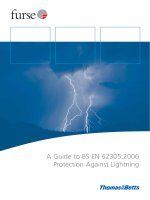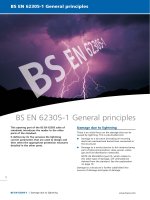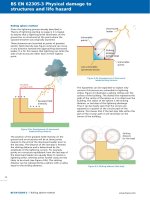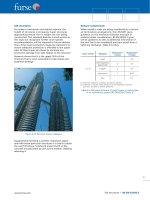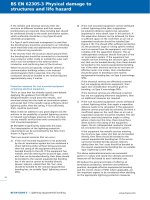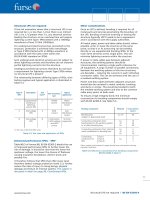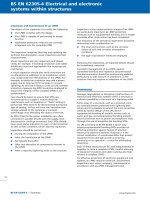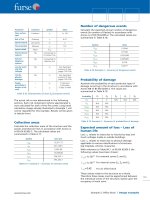Bsi bs en 00409 2009
Bạn đang xem bản rút gọn của tài liệu. Xem và tải ngay bản đầy đủ của tài liệu tại đây (1.2 MB, 14 trang )
BRITISH STANDARD
Timber structures
— Test methods —
Determination of the
yield moment of dowel
type fasteners
ICS 91.080.20
NO COPYING WITHOUT BSI PERMISSION EXCEPT AS PERMITTED BY COPYRIGHT LAW
BS EN 409:2009
BS EN 409:2009
National foreword
This British Standard is the UK implementation of EN 409:2009. It
supersedes BS EN 409:1993 which is withdrawn.
The UK participation in its preparation was entrusted to Technical
Committee B/518, Structural timber.
A list of organizations represented on this committee can be obtained on
request to its secretary.
This publication does not purport to include all the necessary provisions
of a contract. Users are responsible for its correct application.
Compliance with a British Standard cannot confer immunity
from legal obligations.
This British Standard
was published under the
authority of the Standards
Policy and Strategy
Committee on 30 April
2009
© BSI 2009
ISBN 978 0 580 56919 7
Amendments/corrigenda issued since publication
Date
Comments
BS EN 409:2009
EUROPEAN STANDARD
EN 409
NORME EUROPÉENNE
EUROPÄISCHE NORM
April 2009
ICS 91.080.20
Supersedes EN 409:1993
English Version
Timber structures - Test methods - Determination of the yield
moment of dowel type fasteners
Structures en bois - Méthodes d'essais - Détermination du
moment plastique des organes d'assemblage de type tige
Holzbauwerke - Prüfverfahren - Bestimmung des
Flimoments von stiftfưrmigen Verbindungsmitteln
This European Standard was approved by CEN on 2 November 2006.
CEN members are bound to comply with the CEN/CENELEC Internal Regulations which stipulate the conditions for giving this European
Standard the status of a national standard without any alteration. Up-to-date lists and bibliographical references concerning such national
standards may be obtained on application to the CEN Management Centre or to any CEN member.
This European Standard exists in three official versions (English, French, German). A version in any other language made by translation
under the responsibility of a CEN member into its own language and notified to the CEN Management Centre has the same status as the
official versions.
CEN members are the national standards bodies of Austria, Belgium, Bulgaria, Cyprus, Czech Republic, Denmark, Estonia, Finland,
France, Germany, Greece, Hungary, Iceland, Ireland, Italy, Latvia, Lithuania, Luxembourg, Malta, Netherlands, Norway, Poland, Portugal,
Romania, Slovakia, Slovenia, Spain, Sweden, Switzerland and United Kingdom.
EUROPEAN COMMITTEE FOR STANDARDIZATION
COMITÉ EUROPÉEN DE NORMALISATION
EUROPÄISCHES KOMITEE FÜR NORMUNG
Management Centre: Avenue Marnix 17, B-1000 Brussels
© 2009 CEN
All rights of exploitation in any form and by any means reserved
worldwide for CEN national Members.
Ref. No. EN 409:2009: E
BS EN 409:2009
EN 409:2009 (E)
Contents
Page
Foreword ..............................................................................................................................................................3
1
Scope ......................................................................................................................................................4
2
Normative references ............................................................................................................................4
3
Terms and definitions ...........................................................................................................................4
4
Symbols and abbreviations ..................................................................................................................4
5
Requirements .........................................................................................................................................4
6
6.1
6.2
6.3
6.4
6.5
6.6
6.7
Test methods..........................................................................................................................................5
Principle ..................................................................................................................................................5
Materials .................................................................................................................................................5
Apparatus ...............................................................................................................................................6
Preparation of the specimen ................................................................................................................6
Loading procedure ................................................................................................................................6
Results ....................................................................................................................................................7
Test report ..............................................................................................................................................7
Annex A (informative) Bending apparatus........................................................................................................9
2
BS EN 409:2009
EN 409:2009 (E)
Foreword
This document (EN 409:2009) has been prepared by Technical Committee CEN/TC 124 “Timber structures”,
the secretariat of which is held by SFS.
This European Standard shall be given the status of a national standard, either by publication of an identical
text or by endorsement, at the latest by October 2009, and conflicting national standards shall be withdrawn at
the latest by October 2009.
This document supersedes EN 409:1993.
The following changes have been introduced in this version of EN 409:
- references added in Clause 2;
- symbols added in 4;
- text of 6.5 modified and extended;
- Figure 4 added;
- items added in 6.7.
www.bzfxw.com
According to the CEN/CENELEC Internal Regulations, the national standards organizations of the following
countries are bound to implement this European Standard: Austria, Belgium, Bulgaria, Cyprus, Czech
Republic, Denmark, Estonia, Finland, France, Germany, Greece, Hungary, Iceland, Ireland, Italy, Latvia,
Lithuania, Luxembourg, Malta, Netherlands, Norway, Poland, Portugal, Romania, Slovakia, Slovenia, Spain,
Sweden, Switzerland and United Kingdom.
3
BS EN 409:2009
EN 409:2009 (E)
1
Scope
This European Standard specifies a method for determining the yield moment of dowel type fasteners.
2
Normative references
The following referenced documents are indispensable for the application of this document. For dated
references, only the edition cited applies. For undated references, the latest edition of the referenced
document (including any amendments) applies.
EN 14592, Timber structures — Dowel-type fasteners — Requirements
3
Terms and definitions
For the purposes of this document, the following terms and definitions apply.
3.1
dowel type fastener
fasteners specified in EN 14592
3.2
yield moment
bending moment when the specimen is deformed through a prescribed rotation angle
4
www.bzfxw.com
Symbols and abbreviations
For the purposes of this document, the following symbols and abbreviations apply.
d
nominal dowel type diameter according to EN 14592, in millimetres
F1, F3
maximum support loads on the dowel type fastener, in newtons
F2, F4
test loads applied to the dowel type fastener, in newtons
l1, l3
distances between loading points and the nearest support, in millimetres, see Figure 1
l2
free length of the nail in millimetres, see Figure 1
My
yield moment of the dowel type fastener, in newton millimetres
α , α1, α2 rotation angle, in degrees
ρk
is the characteristic density of the timber, in kg/m
ft
is the tensile strength of the fastener, N/mm
5
3
2
Requirements
The requirements for dowel type fasteners as given in EN 14592 apply.
4
BS EN 409:2009
EN 409:2009 (E)
6
6.1
Test methods
Principle
The principle of the test involves the loading of the dowel type fastener under test as shown in Figure 1 in
such a manner that the loading points do not move along the dowel type fastener and the loads remain normal
to the axis of the dowel type fastener during the test. The dimensions l1 and l3 shall be at least 2d. The free
length of the dowel type fastener, l2, shall be between d and 3d.
www.bzfxw.com
Figure 1 — Example of loading principle for nails
Figure 2 — Example of nail deformation
6.2
Materials
EN 14592 applies.
5
BS EN 409:2009
EN 409:2009 (E)
6.3
Apparatus
The apparatus used for the test shall be such that the loads F2 and F4 (see Figures 1 and 2) do not deviate by
more than 5 % from each other. The bending moment diagram for the resulting yield moment My is shown in
Figure 3.
NOTE
A test apparatus, which has been found to be suitable for this test, is shown in Annex A.
Figure 3 — Yield moment My on the dowel type fastener
6.4
Preparation of the specimen
The nail shall be tested about its weakest axis.
6.5
Loading procedure
6.5.1
www.bzfxw.com
General
The load shall be applied to the dowel type fastener as shown in Figure 1, and shall be increased at such a
rate that at least the rotation angle according to 6.5.2 is reached in 10 s ± 5 s. Record the loads and the
corresponding values of the rotation angle during the test.
The load shall be determined to an accuracy of 1 %.
6.5.2
Rotation angle
For nails and staples the rotation angle shall be 45°.
For screws, dowels or bolts used in wood based products the rotation angle is 110/d degree.
2
For screws, dowels or bolts with a tensile strength of 1 000 N/mm used in timber with a characteristic density
3
of 360 kg/m the rotation angle is given in Figure 4.
For different tensile strength values or/and different characteristic timber density the rotation angle is:
2,78 ρ k
α = α1
ft
where
6
0 , 44
+ α2
(1)
BS EN 409:2009
EN 409:2009 (E)
α
is the rotation angle to be used in the determination of the yield moment, in degrees;
α1
is the rotation angle according to Figure 4, in degrees;
α2
is 10° for nails, staples and screws and 0° for dowels and bolts;
ρk
is the characteristic density of the timber where fastener is to be applied, kg/m ;
ft
is the tensile strength of the fastener, N/mm .
6.6
3
2
Results
Determine the load, F1 and F3, at the rotation angle α according to 6.5.2.
The yield moment, My, shall be calculated as given by:
F1x l1
M y = max
F3 x l3
(2)
R
and shall be determined to an accuracy of 1 %.
20,0
18,0
16,0
14,0
12,0
10,0
8,0
6,0
4,0
2,0
0,0
www.bzfxw.com
8
10
12
14
16
18
20
22
24
26
28
30
d
Key
R
rotation angle, α1, in degrees
d
diameter of the dowel type fastener, in mm
Figure 4 — Rotation angle versus fastener diameter
6.7
Test report
The test report shall include the following information:
a)
description of the dowel type fastener;
b)
description of the test apparatus;
7
BS EN 409:2009
EN 409:2009 (E)
c)
location of the free length, l2, along the shank of the dowel type fastener in the test;
d)
tensile strength of the steel;
e)
characteristic wood density;
f)
graphs plotting the values of the rotation angle and load;
g)
rotation angle used for calculating the yield moment;
h)
value of the yield moment;
i)
failure mode of the fastener at the rotation given by Equation (1).
j)
reference to this European Standard, i.e. EN 409:2009
www.bzfxw.com
8
BS EN 409:2009
EN 409:2009 (E)
Annex A
(informative)
Bending apparatus
A.1 Apparatus
Key
1) fastener
2) loose fitting bushing
3) arm
4) loose fitting bushing
5) lever
6) rod
7) load gauge
8) nail
A) rotation point
Figure A.1 — Example of loading apparatus for nails
A bending apparatus suitable for nails is shown in Figure A.1 and consists of the following:
a) the nail under test (1) is held at one end in a loose fitting bushing (2) fixed to an arm (3) that can be
rotated about point A;
b) the other end of the nail is put into a loose fitting bushing (4) which is fixed to a lever (5);
9
BS EN 409:2009
EN 409:2009 (E)
c) the lever (5) is suspended on a load gauge (7) by a rod (6) having freely rotating joints at both ends
and having its axis perpendicular to the lever.
The dimensions:
h from the axis of rotation, point A in Figure A.1, to the axis of the nail and
b between the axis of rotation A and the leading edge of arm (3)
shall be so small in relation to the lengths of the lever 14 and of the rod 15 that the right angle between the rod
and lever does not change by more than 0,1 rad during testing.
The lever shall be stiff compared to the nail.
With the arm (3) resting on the nail and the load gauge (7) set to zero the test shall be commenced by rotating
arm (3) about axis A until the condition of yield within the free length ~ is reached. The length of bushings (2)
and (4) shall not differ by more than 5 %.
A.2 Expression of results
Fmax x l4
M y = max
Glev.
Fmax l4 + 1 − 2 F
max
x l2
where
Frnax
is the maximum load on the gauge, in newtons;
Gtev
is the self weight of the lever, in newtons;
l2
is the free length of the nail, in millimetres;
l4
is the length of the lever, in millimetres.
10
(3)
BS EN 409:2009
This page has been intentionally left blank
BS EN 409:2009
BSI - British Standards Institution
BSI is the independent national body responsible for preparing British
Standards. It presents the UK view on standards in Europe and at the
international level. It is incorporated by Royal Charter.
Revisions
British Standards are updated by amendment or revision. Users of British
Standards should make sure that they possess the latest amendments or
editions.
It is the constant aim of BSI to improve the quality of our products and services.
We would be grateful if anyone finding an inaccuracy or ambiguity while using
this British Standard would inform the Secretary of the technical committee
responsible, the identity of which can be found on the inside front cover. Tel:
+44 (0)20 8996 9000. Fax: +44 (0)20 8996 7400.
BSI offers members an individual updating service called PLUS which ensures
that subscribers automatically receive the latest editions of standards.
Buying standards
Orders for all BSI, international and foreign standards publications should be
addressed to Customer Services. Tel: +44 (0)20 8996 9001. Fax: +44 (0)20 8996
7001 Email: You may also buy directly using a debit/credit
card from the BSI Shop on the Website />In response to orders for international standards, it is BSI policy to supply the
BSI implementation of those that have been published as British Standards,
unless otherwise requested.
Information on standards
BSI provides a wide range of information on national, European and
international standards through its Library and its Technical Help to Exporters
Service. Various BSI electronic information services are also available which
give details on all its products and services. Contact Information Centre. Tel:
+44 (0)20 8996 7111 Fax: +44 (0)20 8996 7048 Email:
Subscribing members of BSI are kept up to date with standards developments
and receive substantial discounts on the purchase price of standards. For details
of these and other benefits contact Membership Administration. Tel: +44 (0)20
8996 7002 Fax: +44 (0)20 8996 7001 Email:
Information regarding online access to British Standards via British Standards
Online can be found at />Further information about BSI is available on the BSI website at http://
www.bsigroup.com.
Copyright
BSI Group
Headquarters 389
Chiswick High Road,
London, W4 4AL, UK
Tel +44 (0)20 8996 9001
Fax +44 (0)20 8996 7001
www.bsigroup.com/
standards
Copyright subsists in all BSI publications. BSI also holds the copyright, in the
UK, of the publications of the international standardization bodies. Except as
permitted under the Copyright, Designs and Patents Act 1988 no extract may
be reproduced, stored in a retrieval system or transmitted in any form or by any
means – electronic, photocopying, recording or otherwise – without prior written
permission from BSI.
This does not preclude the free use, in the course of implementing the standard,
of necessary details such as symbols, and size, type or grade designations. If
these details are to be used for any other purpose than implementation then the
prior written permission of BSI must be obtained.
Details and advice can be obtained from the Copyright and Licensing Manager.
Tel: +44 (0)20 8996 7070 Email:

